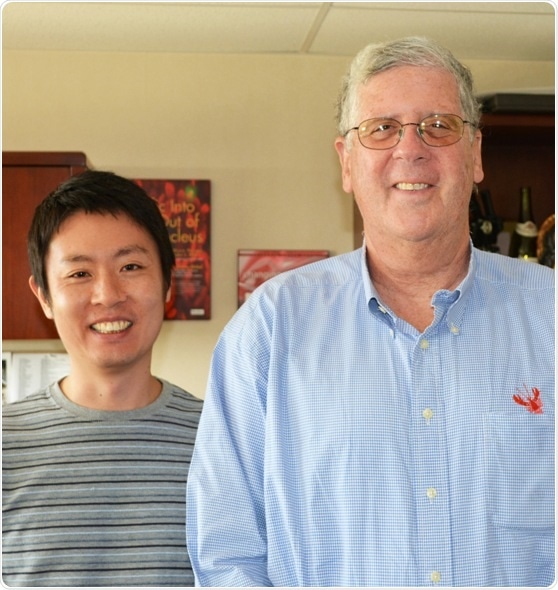A common class of drugs for vision loss may actually add to the problem in some patients, according to new research co-led by scientists at The Scripps Research Institute (TSRI).

Professor Martin Friedlander (right) and Research Associate Susumu Sakimoto led the work at The Scripps Research Institute with first author Lindsay Keir (not pictured). (Photo by Madeline McCurry-Schmidt.)
The new study in animal models suggests that some therapies for age-related wet macular degeneration (ARMD) may leave the eyes—and kidneys—of some patients vulnerable to cellular damage by hampering the body’s ability to make a protective molecule called inhibitory complement factor H (CFH). The study is also the first to identify a common pathway in two seemingly disparate organs: the eye and the kidney.
“This suggests we need to be more cautious in our approach with patients,” said TSRI Professor Martin Friedlander, who co-led the study with Moin A. Saleem of the University of Bristol.
The findings were published December 5, 2016, online ahead of print in The Journal of Clinical Investigation.
A Link to Cellular Damage
The new study focused on vascular endothelial growth factor (VEGF), a molecule that drives the development of new blood vessels, regulates their permeability and maintains their normal function. In cases of age-related wet macular degeneration, VEGF causes leaky blood vessels to grow in the eye, leading to vision loss as blood and cellular debris escape the vessels.
To counter blood vessel growth, patients with age-related macular degeneration are frequently prescribed medication composed of VEGF inhibitors to reduce their levels of the molecule. About one-third of patients respond well to treatments, but about one-third do not respond and one-third have continued or increased vision loss.
“We don’t know why some patients get worse—perhaps because we haven’t been asking the right questions,” said Friedlander, who is also a practicing retina specialist in the Division of Ophthalmology at The Scripps Clinic of Scripps Health.
VEGF inhibitors are also used as anti-cancer drugs, and a known side effect of this is kidney problems that can range from raised blood pressure and development of protein in the urine to severe damage to the kidney filtration unit, the glomerulus, particularly its blood vessels. It was thought that the doses given to age-related wet macular degeneration patients into the eye were too small to have these effects; however, there have been reports to suggest that some patients are susceptible to these side effects, too.
Scientists in previous studies had also observed that both eye and kidney disease patients frequently had a mutation (or “polymorphism”) that decreased their ability to produce functional CFH, leaving cells vulnerable to damage.
This observation led Friedlander and his colleagues to study this medication’s connection to side effects in the eyes and the kidneys.
A Potentially Harmful Combination
The researchers knocked out the ability of mouse models to produce VEGF and found that the animals could no longer produce CFH, leaving their cells vulnerable to damage. Similar results were found in both the eye and the kidney. The researchers saw the same phenomenon when they blocked VEGF with the use of inhibitors.
This led the team to conclude that VEGF inhibitors appear to cause unintended consequences as a result of VEGF inhibition and an associated reduction in the synthesis of CFH. In addition, the scientists observed that CFH synthesis ceased in the eye’s retinal pigment epithelium (RPE) cells and the main cells in the kidney filtration unit (the glomerulus) without VEGF. This had not been described before and the kidney cells studied had not previously been shown to produce CFH.
Furthermore, models with the CFH polymorphism were indeed more vulnerable to cellular damage.
“We found evidence that the polymorphism associated with ARMD could change the function of the CFH protein, making it less effective at protecting cells from damage,” said study first author Lindsay S. Keir, previously at TSRI and the University of Bristol and currently at Northwestern University.
Finally, the researchers created RPE cells from induced pluripotent stem cells, a kind of adult stem cell that can differentiate into any cell in the body. Again, the team saw that cells with the CFH mutation responded differently to VEGF inhibition. This was compared to kidney cells obtained for a patient with a known CFH gene mutation who had a kidney disease called atypical hemolytic uremic syndrome.
“We concluded that if you have the CFH polymorphism, and you’re treated with a VEGF antagonist, you’re at much higher risk of developing a worse disease,” said Friedlander.
“More work is needed to precisely determine which patients are at risk, but it would be prudent to monitor patients for kidney side effects so that any problems can be picked up early,” added Keir.
The researchers also believe doctors could take steps now by reducing VEGF inhibitor treatments if they don’t appear to be working and considering screening patients for the CFH mutation.